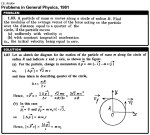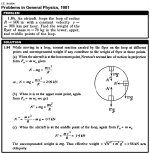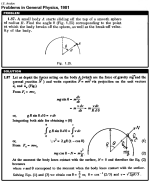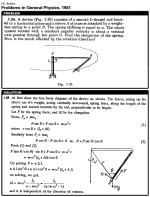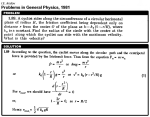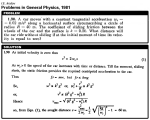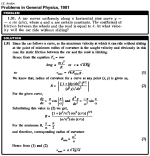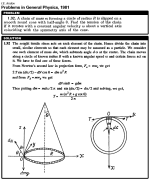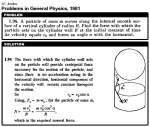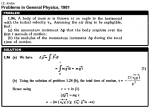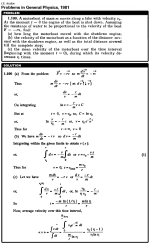| № |
Condition |
free/or 0.5$ |
| 81 | Prism 1 of mass m1 and with angle α (see Fig. 1.23) rests on a horizontal surface. Bar 2 of mass m2 is placed on the prism. Assuming the friction to be negligible, find the acceleration of the prism. |
|
| 82 | In the arrangement shown in Fig. 1.24 the masses m of the bar and M of the wedge, as well as the wedge angle a, are known. The masses of the pulley and the thread are negligible. The friction is absent. Find the acceleration of the wedge M. |
|
| 83 | A particle of mass m moves along a circle of radius R. Find the modulus of the average vector of the force acting on the particle over the distance equal to a quarter of the circle, if the particle moves (a) uniformly with velocity v; (b) with constant tangential acceleration wt the initial velocity being equal to zero. |
|
| 84 | An aircraft loops the loop of radius R = 500 m with a constant velocity v = 360 km per hour. Find the weight of the flyer of mass m = 70 kg in the lower, upper, and middle points of the loop. |
|
| 85 | A small sphere of mass m suspended by a thread is first taken aside so that the thread forms the right angle with the vertical and then released. Find: (a) the total acceleration of the sphere and the thread tension as a function of θ, the angle of deflection of the thread from the vertical; (b) the thread tension at the moment when the vertical component of the sphere s velocity is maximum; (c) the angle θ between the thread and the vertical at the moment when the total acceleration vector of the sphere is directed horizontally. |
|
| 86 | A ball suspended by a thread swings in a vertical plane so that its acceleration values in the extreme and the lowest position are equal. Find the thread deflection angle in the extreme position. |
|
| 87 | A small body A starts sliding off the top of a smooth sphere of radius R. Find the angle θ (Fig. 1.25) corresponding to the point at which the body breaks off the sphere, as well as the break-off velocity of the body. |
|
| 88 | A device (Fig. 1.26) consists of a smooth L-shaped rod located in a horizontal plane and a sleeve A of mass m attached by a weightless spring to a point B. The spring stiffness is equal to χ. The whole system rotates with a constant angular velocity ω about a vertical axis passing through the point O. Find the elongation of the spring. How is the result affected by the rotation direction? |
|
| 89 | A cyclist rides along the circumference of a circular horizontal plane of radius R, the friction coefficient being dependent only on distance r from the centre O of the plane as k = k0(1 - r/R), where k0 is a constant. Find the radius of the circle with the centre at the point along which the cyclist can ride with the maximum velocity. What is this velocity? |
|
| 90 | A car moves with a constant tangential acceleration wτ = 0.62 m/s2 along a horizontal surface circumscribing a circle of radius R = 40 m. The coefficient of sliding friction between the wheels of the car and the surface is k = 0.20. What distance will the car ride without sliding if at the initial moment of time its velocity is equal to zero? |
|
| 91 | A car moves uniformly along a horizontal sine curve y = a sin (x/α), where a and α are certain constants. The coefficient of friction between the wheels and the road is equal to k. At what velocity will the car ride without sliding? |
|
| 92 | A chain of mass m forming a circle of radius R is slipped on a smooth round cone with half-angle θ. Find the tension of the chain if it rotates with a constant angular velocity ω about a vertical axis coinciding with the symmetry axis of the cone. |
|
| 93 | A fixed pulley carries a weightless thread with masses m1 and m2 at its ends. There is friction between the thread and the pulley. It is such that the thread starts slipping when the ratio m2/m1 = n0. Find: (a) the friction coefficient; (b) the acceleration of the masses when m2/m1 = n > n0 |
|
| 94 | A particle of mass m moves along the internal smooth surface of a vertical cylinder of radius R. Find the force with which the particle acts on the cylinder wall if at the initial moment of time its velocity equals v0 and forms an angle a with the horizontal. |
|
| 95 | Find the magnitude and direction of the force acting on the particle of mass m during its motion in the plane xy according to the law x = a sin ωt, y = b cos ωt, where a, b, and ω are constants. |
|
| 96 | A body of mass m is thrown at an angle to the horizontal with the initial velocity v0. Assuming the air drag to be negligible, find: (a) the momentum increment Δp that the body acquires over the first t seconds of motion; (b) the modulus of the momentum increment Δp during the total time of motion. |
|
| 97 | At the moment t = 0 a stationary particle of mass m experiences a time-dependent force F = at(τ - t), where a is a constant vector, τ is the time during which the given force acts. Find: (a) the momentum of the particle when the action of the force discontinued; (b) the distance covered by the particle while the force acted. |
|
| 98 | At the moment t = 0 a particle of mass m starts moving due to a force F = F0 sin ωt, where F0 and ω are constants. Find the distance covered by the particle as a function of t. Draw the approximate plot of this function. |
|
| 99 | At the moment t = 0 a particle of mass m starts moving due to a force F = F0 cos ωt, where F0 and ω are constants. How long will it be moving until it stops for the first time? What distance will it traverse during that time? What is the maximum velocity of the particle over this distance? |
|
| 100 | A motorboat of mass m moves along a lake with velocity v0. At the moment t = 0 the engine of the boat is shut down. Assuming the resistance of water to be proportional to the velocity of the boat F = -rv, find: (a) how long the motorboat moved with the shutdown engine; (b) the velocity of the motorboat as a function of the distance covered with the shutdown engine, as well as the total distance covered till the complete stop; (c) the mean velocity of the motorboat over the time interval (beginning with the moment t = 0), during which its velocity decreases η times. |
|


